And they can’t even make my heating work properly. But we do not live in southern countries, where you can adjust the temperature in the apartment without any problems. In Russia, people freeze every winter, this has already become a tradition and many do not fight the cold. But there is a way out of this unpleasant situation, or rather two at once - to fight with public utilities and demand heating, or to still fork out money to buy a high-quality heater that can warm you in the most severe frosts.
But choosing a heater is very difficult, because they run on natural gas, liquid fuel or electricity. Although you can more often find heaters that run on electricity, they are divided into several types: convectors, oil radiators, infrared quartz and fan heaters. Of course, people don’t know what this means and which heater will be more efficient and better value for money, and that’s why we’ve dedicated an entire article to it.
There are the following types of heaters from which you should choose:
Oil
Back in Soviet times, everyone had electric batteries, which were always noisy because of oil instead of water. But they have their pros and cons, which we will write about below.
Advantages:
- There is no need to constantly repair or maintain the heater; you just need to shake off the dust with a cloth. They consume only 2 kW per hour, which makes them quite economical. The heater is available to everyone, it low price quickly attracts buyers.
- It takes longer to heat up than others, but retains heat very well. If there is no heating in the house, it maintains the optimal temperature in the room because the system is working automatic switching on and shutdowns.
- It is advisable to purchase an oil heater with a fan, this way you will warm up the air faster and retain the heat for a very long time.
- A large number of sections has its advantages; if there are 10 of them, the heat transfer will accelerate and the room will be warm even in the most severe frosts.
- They have wheels, which means that you can transport the heater to the coldest room without any problems.
- You can save energy thanks to the timer. For example, set the timer half an hour before returning home after guests or work, and upon arrival the apartment will already be warm. Such programming of the heater increases the comfort of use.
Flaws:
- It is impossible to install in a small apartment, since the heater will take up a lot of space.
- You can get burned on it, which means that small children should be kept away from the heater, and they should not be left at home with the device on.
- You cannot cover it with a cloth and try to dry clothes on it, this is very dangerous, and this applies to all models of heaters.
- An oil heater should not be used in damp areas under any circumstances.
- Lack of oxygen due to burning air, an oil heater burns air, and therefore if you can only breathe freely with pure oxygen, it is not suitable for you. You can buy a special air freshener humidifier separately, but as mentioned above, moisture is contraindicated. You should not buy two in one, both a heater and a humidifier, similar models are not known for their practicality.
It is more reminiscent of an oil heater in its performance characteristics. It is installed in country houses, offices, apartments, and even used as basic system heating. In general, you can install it anywhere. Convector models from Noirot use the second class of protection, and therefore they do not need to be connected to the electrical network, and grounding is not required at all. Thanks to this, you can keep the heater on all day long and not be afraid of overheating. It is not afraid of wet rooms; it can even be installed in. If you use the convector as intended, the chances of a fire are reduced to zero. 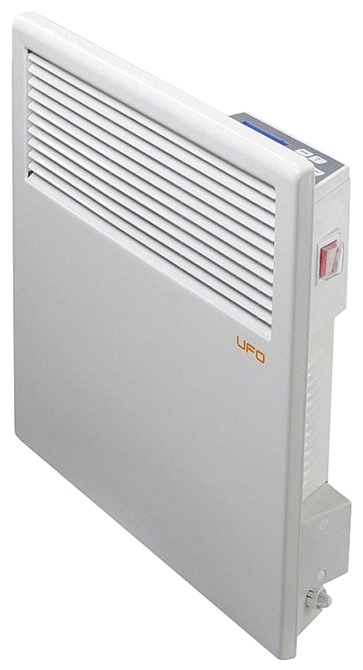
How does a convector work?
The air passes through the heating elements and the room becomes warm. The air circulates both cold and warm, that is, the heated cold air goes up and is replaced again by cold air. A similar process continues throughout the operation of the convector. It is worth noting that the air heats up moderately, and the heating element takes large area. It is advisable to install it lower so that it works even more efficiently. Models come in both floor and wall mounted, so there is plenty to choose from. The most attractive are convectors with a timer - the ability to program the heater to turn on and off.
pros
The air remains clean because it is heated to a temperature of 60 degrees Celsius. The case does not overheat, and the risk of fire is reduced to zero. It is very easy to move thanks to the wheels, and it can be hung on any wall. The efficiency of the convector is 99%, and it heats the room incredibly quickly. There is a timer, you can program it to turn on at a time convenient for you. Small size makes it convenient to install in small apartments. It is also possible to combine the heater with the system electric heating. Reduces the risk of exacerbations of asthma and other respiratory diseases because it does not burn oxygen.
There is no point in talking about the shortcomings; this device simply has no disadvantages.
What are the differences between a mechanical thermostat and an electronic one?
An electronic thermostat has a number of significant advantages:
- The temperature accuracy is the highest, and if you set the temperature, it will be 99% accurate. But the accuracy of a mechanical thermostat is not so high, about 1-3 degrees. And over time, he wears out, and his abilities become even worse. The human body is capable of sensing temperature down to the slightest change, even one degree is strongly felt, which is why mechanical thermostats are inferior to electronic ones.
- A mechanical thermostat makes noise, but an electronic thermostat does not make any noise at all.
- Will last electronic thermostat longer, its quality is much higher, so you don’t have to spend money on buying a new heater.
- Changes in the network do not affect the electronic thermostat; it still accurately maintains the temperature. People in the West have not even heard about changes, but in Ukraine, changes occur regularly.
Electric fireplace
Of course, many of you immediately remembered the wonderful design of fireplaces that we see in many restaurants and cottages. But electric fireplaces run on electricity and have nothing in common with antique fireplaces other than their appearance. Previously, one could openly see that it was just lighting and some strange outer covering, but now technology has stepped forward and electric fireplaces are very similar to real ones, even in their operating principle. Nowadays electric fireplaces are called IR heaters. The appearance is very realistic, there is no longer a picture of a fireplace, but an exact copy of a natural fire. Fans have been added to the models for better work, the manufacturers did everything to make it look like a real fireplace. 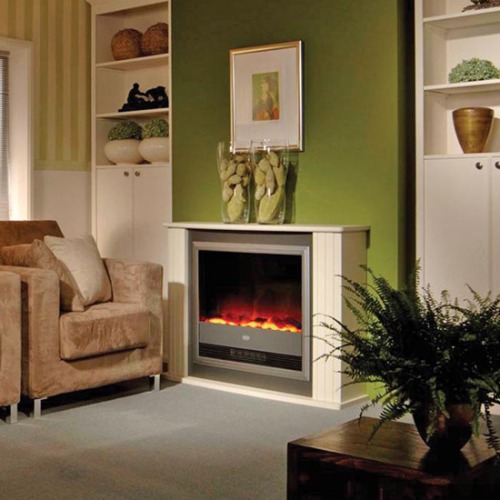
But you need to opt for an electric fireplace if you are a connoisseur of antique fireplaces and appreciate non-standard and unique design in an apartment, because you will have to pay a lot. Very high energy consumption forces owners to pay high electricity bills. If you have a lot of money and you want to improve it, make it more beautiful and beautiful - go ahead, but from a practicality point of view it’s not worth it. To put it simply - a waste of money, if you need an efficient heater, there are more attractive models.
Infrared
Inside the heater there is a special quartz flask and a tungsten filament, and outside the metal casing there is a reflector. When the heater is turned on, the filament becomes hot and distributes heat, namely infrared waves. The operating principle is heating skin and surfaces of objects, and not in heating cold air in the room. The huge advantage is that such models can be installed in large shopping centers and factories, where a conventional heater is not capable of heating the air truly effectively. The heater is not afraid of a draft, because it still warms the person. Great for the bathroom, considered best model for the bathroom. 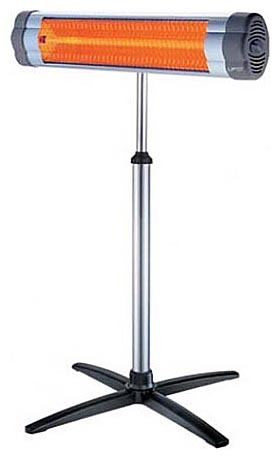
Pros:
- No noise;
- Energy saving;
- Easy to install;
- The heating speed is higher than other heaters;
- Safe;
- Heats even in open rooms.
Minuses:
- Quite a fragile heating element;
- Not good good choice for stationary residential premises;
- A narrow heating zone that is initially installed.
Carbon
This is a completely new model on the heater market. They work in much the same way as conventional quartz heaters, the only difference is that a carbon carbon spiral is involved in the work, and not quartz lamp. Positive traits and disadvantages are identical to infrared heaters, but the efficiency and heating power are much higher. In fact, a carbon coil emits waves much more intensely, but at the same time consumes much less energy than IR heaters. If you look at the statistics, we can say that it saves 25% more energy and works 200% more efficiently than oil heaters. What is most surprising is that the cost of carbon heaters is the same as for other types of heaters, although the performance is much better. 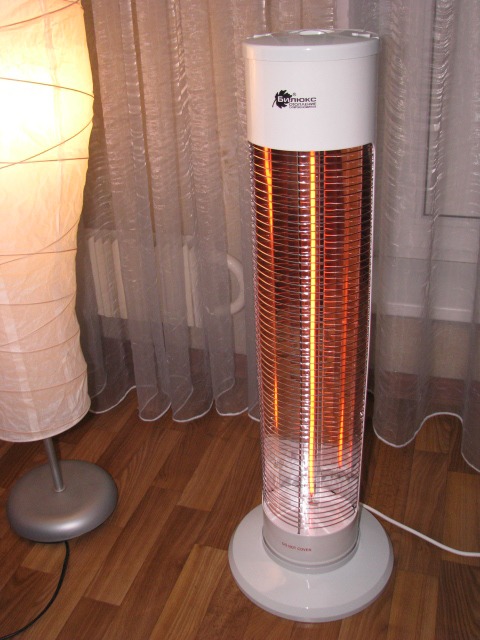
Fan heater
At the moment, fan heaters are very popular. As soon as the cold weather sets in, prices for fan heaters drop dramatically, and you can buy a heater at a discount at a very low price. But you need to know the details about their operation, what is a fan heater and what are its pros and cons? 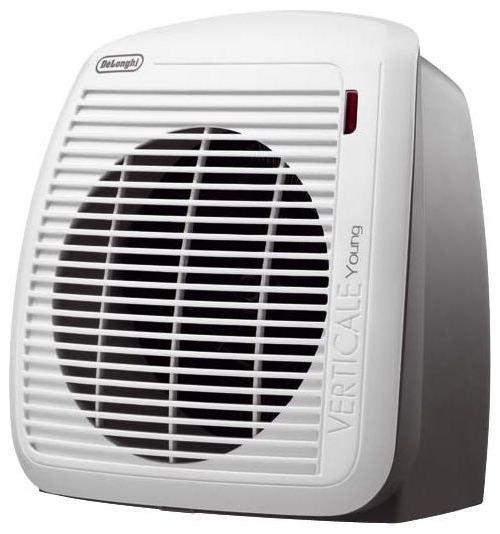
Advantages:
- In small rooms they work very well, but such heating cannot be called heating. At the beginning of the cold weather, it may help, it will quickly dry clothes in the bathroom and warm your cold feet in the office.
- It takes up little space and is very easy to use, making it possible to place the fan in small spaces.
- The fan heater turns off after a fall; there is a function to turn it off and on automatically.
- It does not burn and heats the air only to a temperature of 40 degrees, and therefore it is almost impossible to get burned by it.
- There are table fans, floor fans, and wall fans, so you can choose a fan for all occasions.
Flaws:
- They dry and burn pure oxygen, this is one of the main disadvantages. Moreover, the fan lifts all the dust from the floor into the air, and it gets not only into the lungs, but also into the fan itself, and this threatens a terrible smell throughout the entire apartment.
- Most models make a lot of noise during operation, which is very annoying and gets on your nerves. You can search for models with low level noise, but still, it's not worth it.
Gas
Of course, talk about gas appliances in the section of electric heaters, this is not the most best idea, but since we are talking about heating an apartment, it is worth touching on all known heating methods. There are two types of gas heaters, namely gas convectors, which are part of the heating system, and gas fan heaters. Convectors are similar to regular battery and are not an alternative to heaters, so we will only talk about gas fans.
If you look hard enough, you can find gas fans, but they are not designed for apartments, but for heating outdoors. If you often go to the forest to pick mushrooms or like to go fishing, this model will suit you and will keep you warm in the coldest weather. It warms you up very well on cold nights when you set up a tent and can’t sleep because of the cold. In addition, they take up very little space, which makes them quite practical. There is no point in talking about all the pros and cons, this is not an electric fan, and you still won’t be able to install it at home. 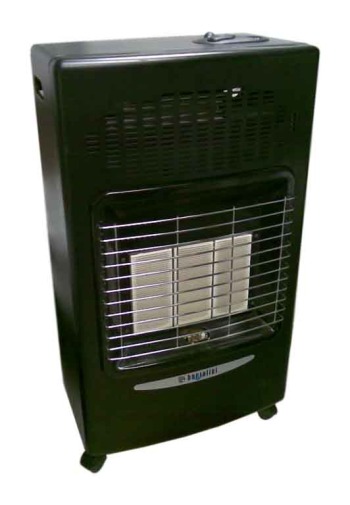
You can use a gas fan on hikes, but there is no point in installing it at home. We have already discussed the most efficient models, which are ideal for your home and from which you can make your choice. Next, we will talk about ceramic fans, which have already replaced conventional fan heaters and have won many positive reviews.
Ceramic
As we have already said, the performance of ceramic fans is significantly higher than that of conventional fans. Dust combustion is impossible, and the air remains clean and fresh, no problems with odor in the apartment. There is an antibacterial lamp and a rotation function, a timer for programming the operating time. Very attractive design fan, which makes it possible to install it in any apartment and not lose in the appearance of the room as a whole. But it also has its drawbacks; you are buying a simple device for not the most better heating quite high price, it is better to prefer other heater models. 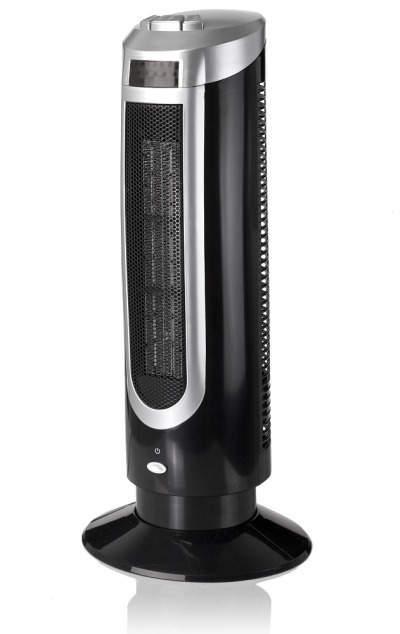
Well, now a useful video on this topic:
As you can see, there are a lot of models, and in some places the design is put first, and in others the practicality and mobility of the heater. Choose a model based on the size of the apartment and the number of residents, take care of safety and do not buy an oil heater if small children live in the apartment.
Even in summer there are cool, rainy days when a heater doesn't seem out of place. The more he is needed early autumn, during the rainy season, as long as the central heating is not turned on. A home heater should be efficient, convenient, easy to use, safe, beautiful, and ideally, economical. Market heating equipment is extensive, the models are very different and operate on different energy sources. Which to choose? How to correlate the conditions in a particular room, the needs and wishes of the owner and the characteristics of the devices? To understand these issues, we will consider the types, designs, and operating features of home heaters.
The choice of heaters is huge. If desired, you can find a model for any interior style
What types of home heaters are there?
Heating appliances can be powered by gas or electricity. Gas is chosen if there is free access to fuel and it is necessary to ensure autonomous system heating This a good option for dachas where people do not live permanently, garages, workshops, but for a house or apartment gas heater Not the best choice. Most buyers prefer electrical appliances and choose from these main types:
- oil radiators;
- convectors;
- infrared;
- quartz heaters;
- heat guns;
- thermal curtains.
Let us immediately make a reservation that heat guns and curtains are rarely used in residential premises. They are good for industrial buildings, institutions, retail outlets, so it makes no sense to consider in detail the features of their work.
Based on their location, devices are divided into:
- floor;
- wall;
- ceiling
There are also “hybrids” - floor models, which are additionally equipped with parts for wall mount. All heaters differ significantly in design and operating principle. Each type has its own advantages and disadvantages. You need to study them carefully to make right choice.
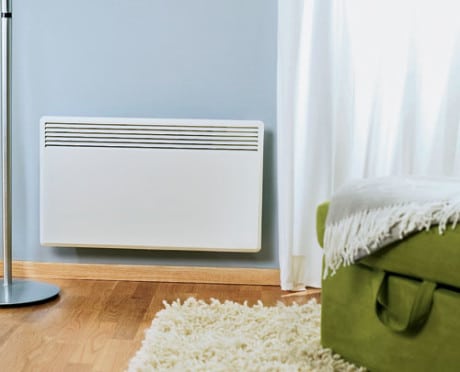
Overview of different types of home heaters
The most common heater is oil. Models of this type have been popular for several decades, and new modifications are constantly appearing. Many buyers buy convectors, infrared heaters, and fan heaters. They also do their job very well. Quartz devices – relatively the new kind heating equipment. They are less common, but no less effective. What's so good about all these devices? What are the restrictions on use?
Oil cooler - an old friend is better than two new ones
In appearance, the device resembles a regular heating radiator and works on the same principle. The power of the device depends on the number of sections. In addition to functionality and ease of operation, the oil radiator has another important advantage - it operates silently. A radiator can heat a room for a long time. Almost all models are equipped with thermostats. No special maintenance required. The main thing is to wipe the device from dust in a timely manner. But there is significant drawback. It is not advisable to install a radiator in houses where there are “foolish people”. The housing may become very hot, and touching it may cause burns. The device dries out the air, so it is better to choose models with ionizers.
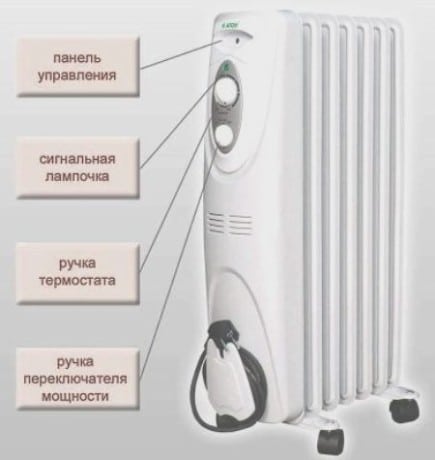
Oil radiator control panel design
Convector: warm and safe
The operating principle of the convector is based on heating and mixing layers of warm and cold air. The device has built-in automation that prevents overheating. The device is silent, but there are models additionally equipped with fans. They warm up the room faster and better, but make a quiet noise. If you are ready to put up with this, the convector will last for many years. Main disadvantage device: together with air, it intensively moves dust. Therefore, if the room has special hygiene requirements, then it is better to choose a different design or constantly carry out wet cleaning. Very comfortable wall models.
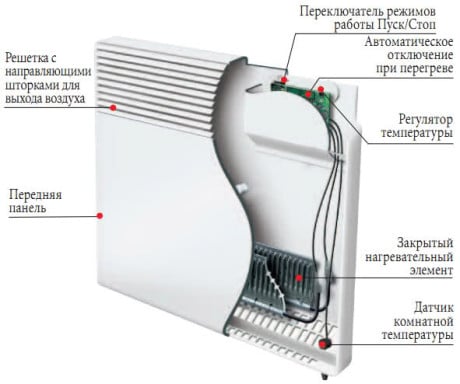
Installation of a wall-mounted electric convector with a thermostat
Fan heater: compactness and speed
Fan heaters work in much the same way as convectors. The fan is placed in front of the heating element. The main advantages are the compact design and the speed of heating the room. Disadvantages: noise during operation, intense spread of dust. After turning off the heater, the room quickly cools down. By installing a fan heater, you can create a local thermal comfort zone in a certain part of the room. To do this, you just need to turn it in the direction of the area that needs quick heating.
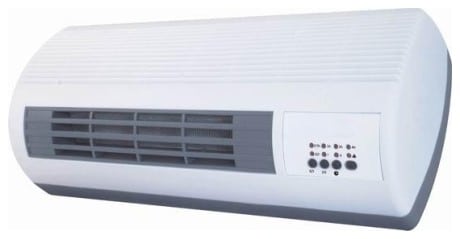
Stylish and neat fan heater
Features of heating a house with infrared heaters
All the best was invented by nature even before the appearance of man. The soft warmth of the sun relaxes and revitalizes. Engineers adopted the principle of radiant heat transfer and created infrared heaters. They heat objects and people, and the air is heated from the warm surfaces. The peculiarity of such devices is the instant creation of a thermal comfort zone. These are comfortable energy saving heaters for home. They are safe and easy to use. Disadvantage: after turning off the device, the room cools down almost immediately.
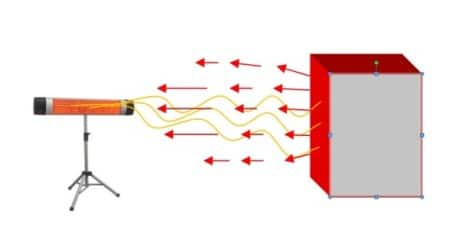
How does it work infrared heater
Lightweight and versatile quartz heaters
These devices are monolithic slabs, inside of which there are chromium-nickel heating elements. They are durable, do not dry out the air, and accumulate heat well. Working temperature relatively low, so quartz heaters are fireproof. The devices are equipped with thermostats, thanks to which these economical heaters consume even less energy. There are floor and wall models. They can be installed in premises of any purpose. Quartz heaters are used as main and additional heating.
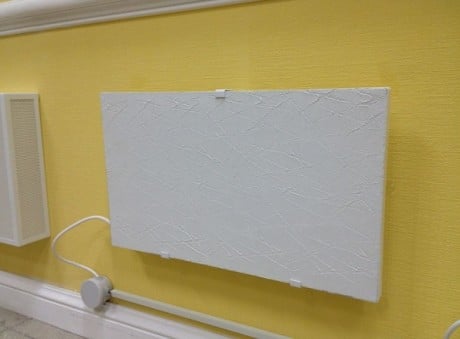
Appearance of a quartz heater
What to consider when choosing a home heater
In order not to make a mistake when choosing a heater model for your home, you need to pay attention to the following nuances:
- Specifications. The power of the device must be sufficient to heat the room in which it will be installed. At the same time, it is desirable that it be economical.
- Area and degree of heating. Sometimes a heater is needed just to warm up the space near a crib or sofa a little, and there is no need to heat the entire room. You can choose a model that will warm up not the air in the room, but objects in a specific area. In this case, the air is heated indirectly - from warm objects.
- Location. Decide which model will be most convenient in specific operating conditions - floor, wall or ceiling.
- Degree of security. For example, for a nursery it is better to choose heaters that will not be on the floor. The case should not get very hot.
- Optional equipment. There are models with air ionizers and others useful additions. Think about what elements might be useful and choose a model according to your needs.
- Design. Everyone has their own ideas about aesthetics. Perhaps a lightweight, stylish convector will fit well into the interior of the room, or maybe you want to decorate the room with an infrared picture heater.
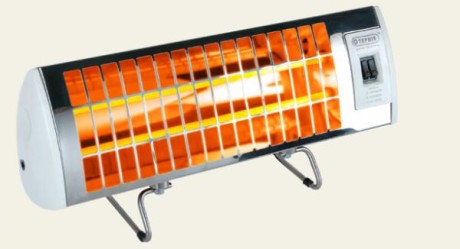
Appearance of a halogen heater
Calculation of the power of the heating device
Traditionally, the calculation formula is used: 1 kW of power per 10 sq.m. area. It turns out that for heating a room with an area of 8-10 sq.m. a model with a power of 1 kW, 15-16 sq.m. is sufficient. – 1.5 kW, and 18-20 – 2 kW. Taking into account the peculiarities of the operation of different types of devices for full heating of a room of 20 sq.m. you need to choose a convector, infrared heater or oil radiator with a power of 2-2.5 kW, and take a fan heater with a small “reserve” - 2.5 kW. If a device is purchased to compensate for the insufficient operating efficiency of the main heating system, you can choose it to be less powerful, or even better, take a model with several heating modes and automation.
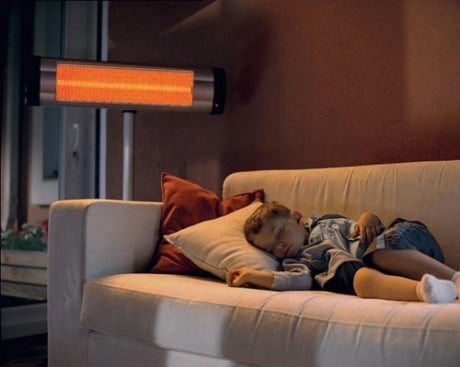
Which heaters are best for your home? It depends on your needs and operating conditions of the equipment. Consider what is most important to you: heating speed, heat storage capacity, safety, hygiene or economy. Choose by technical parameters and based on your own ideas about comfort.
Video: how to choose a heater for your home
With the onset of cold weather, the issue of additional heating of the room becomes acute. Therefore, if your home or office is not warm enough, it’s time to buy a heater. Modern heaters are effective and practical devices for creating a comfortable room temperature not only in the off-season, but also in winter period. Market climate control technology presented wide range various household heaters. How to choose a heater Our project will tell you from all the diversity.
Which type of heater is best?
Oil radiator
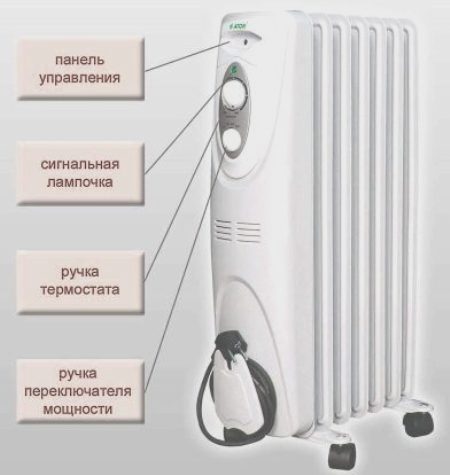
Who hasn't heard of oil radiators? The most common type of household heaters, which is most often used in apartments and offices. A metal radiator contains a coolant, usually distilled water or oil. The coolant is heated thanks to a spiral heating element located inside the housing. When the device is connected to the mains, the coil heats the oil, causing heat to spread into the room through the metal casing. To create a comfortable microclimate, it is important to take into account the power of the device and the volume of the heated room.
The power of an electric oil radiator can be 1 - 2.5 kW. The main difference is the number of sections. Oil radiators can have 5–15 sections. Consequently, the greater their number, the higher the power of the device, which means the greater the heat transfer.
Oil radiators are used for additional heating of apartments, private houses, cottages, office and retail premises, etc.
Advantages
Oil radiators undoubtedly have many advantages:
- Low heating temperature of the casing (does not exceed 60˚C), this means that they are absolutely safe for children and animals;
- Maintaining the set temperature thanks to the presence of a thermostat and a 24-hour timer. Having warmed the room to a certain temperature, the heater turns off automatically. When the temperature drops by 1˚C, the device automatically turns on to additionally heat the air.
- No oxygen burning;
- Mobility. Thanks to the presence of special wheels, the device can be moved or moved to another room.
Flaws
Significant negative aspects, does not have such a radiator, but experts highlight the following as disadvantages:
- Impressive weight (some models can weigh up to 16 kg);
- Large dimensions, causing inconvenience not only during operation, but also during storage of the device;
- Slow heating (due to prolonged heating of the coolant). The average radiator heating time reaches 15-20 minutes.
Convector heaters (convectors)
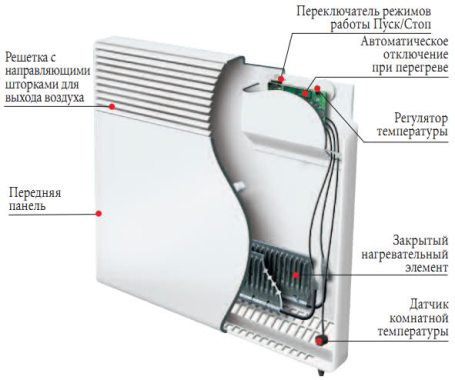
Every year, electric convectors are becoming more and more in demand among ordinary consumers, as the most economical, convenient and efficient type heater. To quickly heat the room, we recommend choose a heater convector type. The principle of its operation is even simpler than that of oil radiators. The air is heated thanks to a heating element (closed or open type), which is located at the bottom of the convector. A special feature of the convector is natural air convection, which ensures efficient heating of the room. The heated air rises, and the cooled air falls down, and the heating process repeats.
As mentioned above, convector heaters can be equipped with closed and open heating elements. Closed heaters are a filament placed in a special ceramic flask. This heating element does not dry out the air and does not burn dust that has fallen on its surface. In addition, it is more durable and reliable. A metal spiral is used as an open heater. It is less reliable, can quickly fail, dries the air, reducing the humidity in the room. Therefore, when using such a heater, we recommend purchasing an additional one to maintain a comfortable level of humidity in the room.
The convector power is 0.5 - 2.5 kW. According to the type of installation, convectors can be wall-mounted or floor-mounted. And now in more detail about the advantages and disadvantages of such heaters.
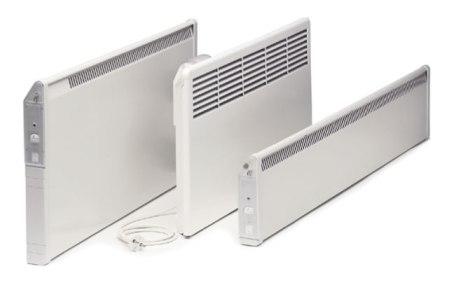
Advantages
- Silence and fire safety;
- Mobility;
- Fast heating (the convector only needs 5-7 minutes to heat the air to the set temperature);
- Built-in heater overheat protection;
- Safety and no burns (casing temperature does not exceed 50˚C);
- The presence of a thermostat and timer;
- Possibility of creating electrical system heating system, consisting of several convectors;
- Light weight;
- Attractive appearance
The only disadvantages include the combustion of oxygen in convector models with an open heater.
Heat guns
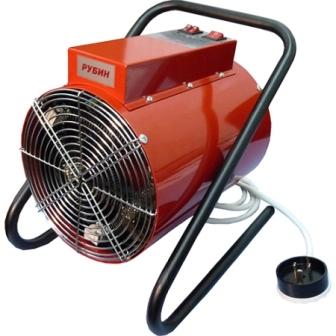
These are quite unique heating devices. The air is heated using a spiral heater. A built-in fan is used to improve the convection of heated air. The main place of application of heat guns is retail and industrial premises, garages, warehouses and construction sites. In rare cases, heat guns are used to heat rooms in residential and administrative buildings.
The power of such a device can range from 2 to 6 kW.
Heaters of this type can be stationary (floor and wall-mounted), as well as mobile devices. At choosing a heater pay attention to its advantages and disadvantages.
Advantages
- Fast heating;
- Mobility;
- Automatic shutdown when tipped over;
- Overheat protection relay heating element;
Flaws
- Noisiness;
- Impressive weight and dimensions;
Heat fans
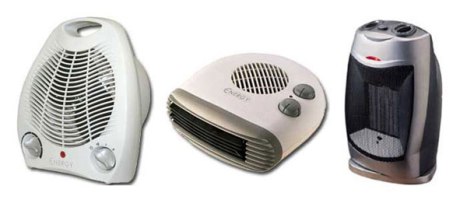
Fan heaters are analogues of heat guns, but are mainly used for heating rooms in residential and administrative buildings. The principle of operation of the devices is to heat cold air and move it throughout the room using a built-in fan. Rapid heating is replaced by equally rapid cooling of the air. Therefore, in order to support comfortable temperature air in the room, it is necessary to keep the fan heater constantly on. Important: do not leave the device unattended to prevent a fire hazard.
The power of the device is 2 - 2.5 kW. Fan heaters can be either wall-mounted or floor-mounted portable. Which heater to choose, you decide.
Like other types of heaters, fan heaters have both advantages and disadvantages.
Advantages
- Fast heating;
- Low cost;
- Overheat protection;
- Light weight and small dimensions
Flaws
- Noisy operation;
- Possibility of burning dust, resulting in the appearance of an unpleasant odor.
Infrared heaters
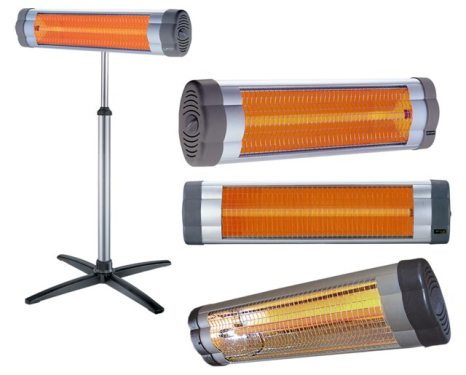
At choosing a heater infrared radiation Special attention It is worth paying attention to the type of heating element and the reliability of the design. As a rule, such devices use quartz and halogen lamps, as well as carbon filaments, as heating elements. Infrared heaters are the simplest and most economical heaters. Their distinctive feature– local directional heating. They do not heat the air, like all the above-mentioned devices, but objects located nearby (furniture, walls, floor). This helps to quickly heat the air in the room.
Infrared heaters can be in floor, wall, ceiling and mobile options execution. Such heaters are used not only for heating closed premises, but also for open areas - terraces, balconies, loggias.
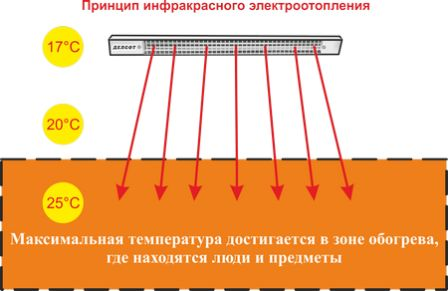
Advantages
- Fast heating;
- Silence;
- Low energy consumption;
- Can be used both in rooms with high humidity levels (showers, bathrooms, swimming pools) and outdoors
Flaws
- Inability to heat large volumes;
- High price
Thermal curtains
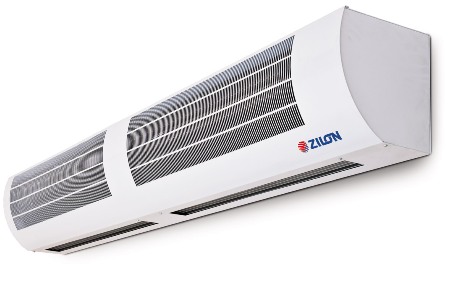 A more complex type of heater, the principle of operation is similar to. Thermal curtains are installed exclusively in window and doorways. Their main purpose is not so much to heat, but to create an obstacle to cold air entering the room. That is why thermal curtains are used in shopping centers, offices and warehouses. They are not entirely appropriate for residential premises.
A more complex type of heater, the principle of operation is similar to. Thermal curtains are installed exclusively in window and doorways. Their main purpose is not so much to heat, but to create an obstacle to cold air entering the room. That is why thermal curtains are used in shopping centers, offices and warehouses. They are not entirely appropriate for residential premises.
The power of thermal curtains ranges from 3 to 12 kW. In order to choose the right curtain model, you need to know two parameters - the width and height of the openings (windows or doors). The width of the opening must correspond to the width of the curtain.
Thermal curtains are mounted in horizontal and vertical positions.
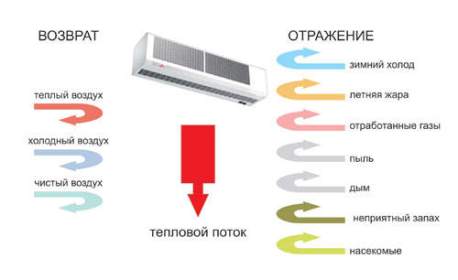
In addition to all the above heaters, air conditioners are used for additional heating of rooms inverter type, electric fireplaces, heaters with quartz, carbon, halogen and micathermic heaters. Today we will not consider these devices, since their operating principle is similar to the most common heaters.
Heater power calculation
In order to choose a heater That's right, you need to calculate the power of the device, which will be enough to effectively heat the room you need.
It is generally accepted that to heat a room of 10 sq.m. A device with a power of 1 kW is sufficient. You can find out more about calculating the required power using the data given in the table.
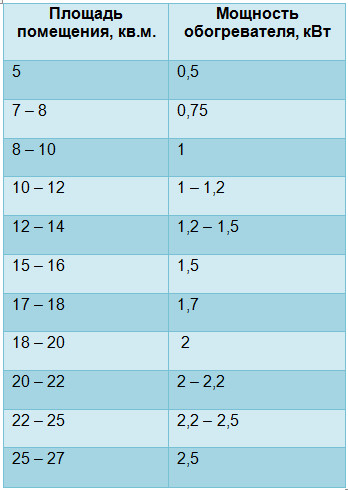
For example:
For basic heating of a room with an area of 20 sq.m. you should choose heaters with the following power:
- oil radiator or convector (2-2.5 kW);
- fan heater (2.5 kW);
For additional heating of a room of the same area, we recommend:
- oil radiator or convector (1.5 kW);
- fan heater (from 1.5 to 2 kW);
- infrared heater (1.5 kW);
We sincerely hope that our material about will help you decide on the necessary device and make a profitable purchase. Comfort and warmth!
One should not think that electric heaters for the home are needed only by those who do not have a central, gas or stove heating. Batteries do not become warm immediately after the onset of cold weather, and heating season you have to wait in cold rooms. In this situation, an apartment heater is the only means of creating comfortable living conditions. Such a device does not have to work daily from October to April, so many do not attach special significance its efficiency. However, with the constant use of electrical equipment for heating, efficiency comes to the fore.
One should not think that electric heaters for the home are needed only by those who do not have central, gas or stove heating.
When purchasing certain heating units, you first need to evaluate how safe they are to operate, and only then give preference to the most economical electric heaters. If the instructions for the device contain a note: “Do not leave unattended,” it cannot be used as the only source of heat in winter time. But even heating devices that are under constant supervision must meet all electrical and fire safety requirements.
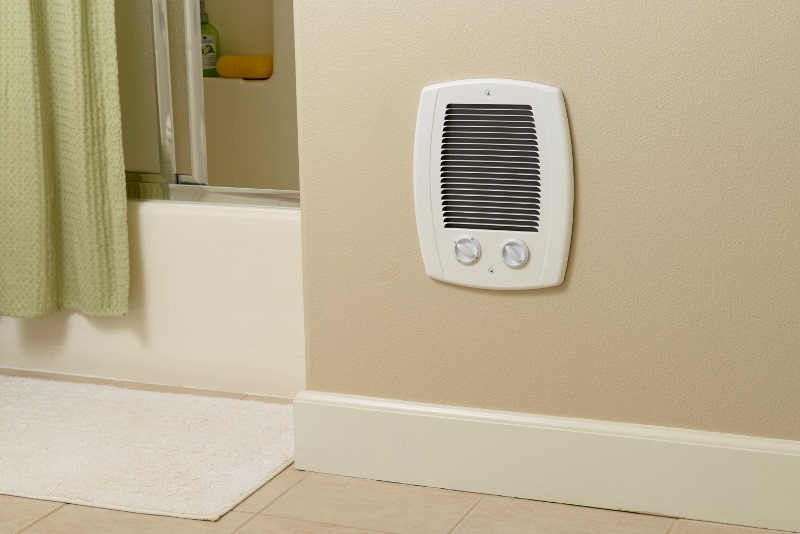
If the family has Small child, it is advisable to focus on models that eliminate the possibility of burns. At night, one of the main requirements is the quiet operation of room heaters. If you need to frequently move the device from room to room, its weight becomes an important factor. The speed of entering the operating mode should also be taken into account, that is, the time required to warm up to optimal temperature. Until it is reached, a fairly high energy consumption occurs. Therefore, during short-term operation (within 1-3 hours), it is irrational to use units with a long period of reaching active indicators.
How to choose a heater (video)
Which is better: a convector or an oil radiator?
A modern oil unit, in comparison with its predecessors, is free of such flaws as excessive heating of the radiator housing. This allows you to avoid burns from accidental touching. But even such an economical heater as the Electrolux EOH/M-6209 model weighs about 9 kg and heats up to the set temperature in about 15 minutes. At the same time, after entering active mode, the unit shows an excellent ratio of power consumption and heat generated. It is beneficial to use it for heating rooms for a long time, and not for several hours a day.
At one time, a lot of criticism was caused by models that in some cases could literally “explode” and flood floors and furniture with hot oil. New models are safe to use and do not similar shortcomings. They are equipped with a sensor, thanks to which the overturned device automatically turns off. They have protection against splashes and overheating. The most economical heaters are equipped with a timer that turns on the device at a specified time.
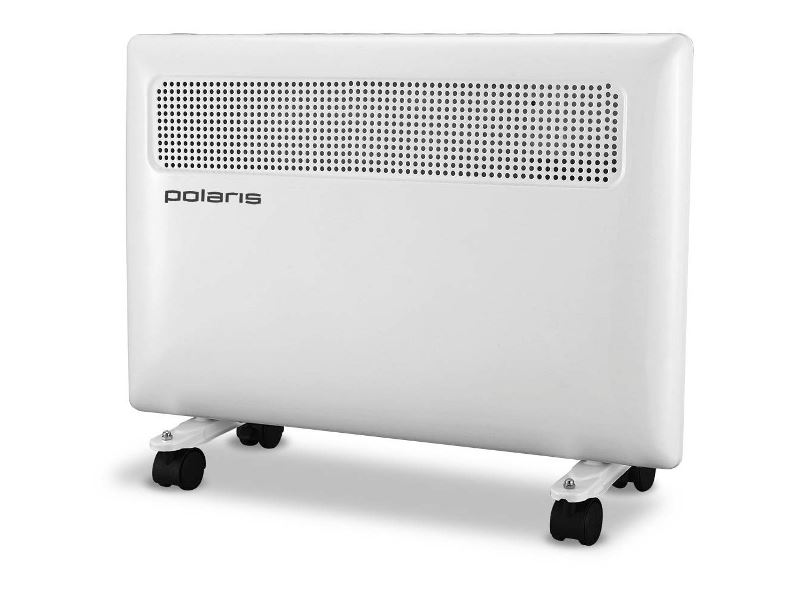
This allows you to avoid using the unit “idle” when no one is at home. Despite the fact that some models weigh more than 20 kg, they are easy to move thanks to wheels and a comfortable handle.
Convectors are so safe that they can be left on and unattended. They are devoid of oil filler, which begins to leak over time if the device does not have a protective casing. The heating element (heating element) directly heats the convector body. There is no risk of burns, since the outside temperature is no more than 60º. Thanks to its light weight and flat surface, the electric heater can not only be installed on the floor, but also hung on walls. Heat from the unit comes due to the natural movement of air masses different temperatures(convection).
The principle of operation of both types of devices is such that they raise dust into the air even without fans, but do not burn oxygen at all, since they do not have open filament coils. Cost comparison various types heaters on the virtual store website household appliances The “5th element” speaks in favor of oil-filled units, however, their efficiency is lower than that of convectors. Only built-in fans can increase heat transfer, and they create additional noise.
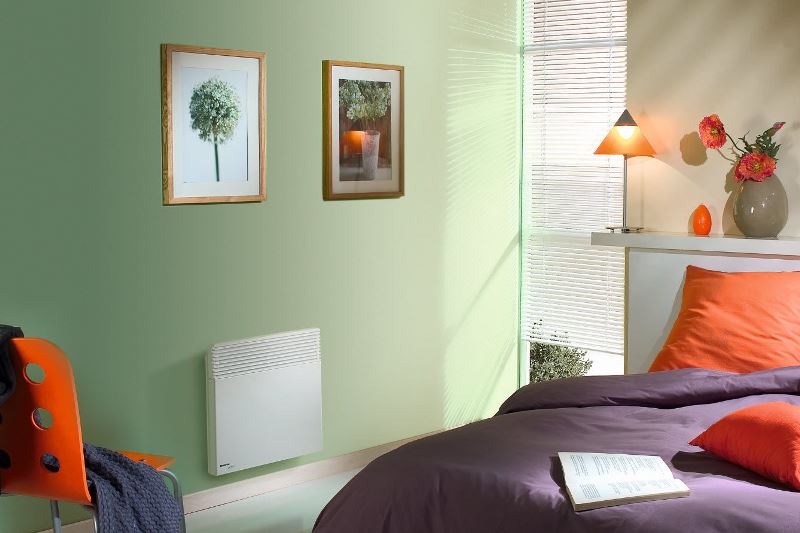
When purchasing certain heating units, you first need to evaluate how safe they are to operate.
Inverters or simple fan heaters?
The fan heater coil heats up almost instantly. The air driven through it quickly heats up and fills the room with warmth. On sale you can find very small portable devices that are somewhat reminiscent of an ordinary hair dryer. They weigh very little and are inexpensive. However, the device consumes a lot of energy, the fan is quite noisy, and oxygen is burned when air passes through the coil. The cheapest models quickly fail. How country option a fan heater is convenient only when you need to quickly warm up, but it is not designed for long work. If the device is turned off, the room will begin to cool down very quickly, so it is far from the most economical heater.
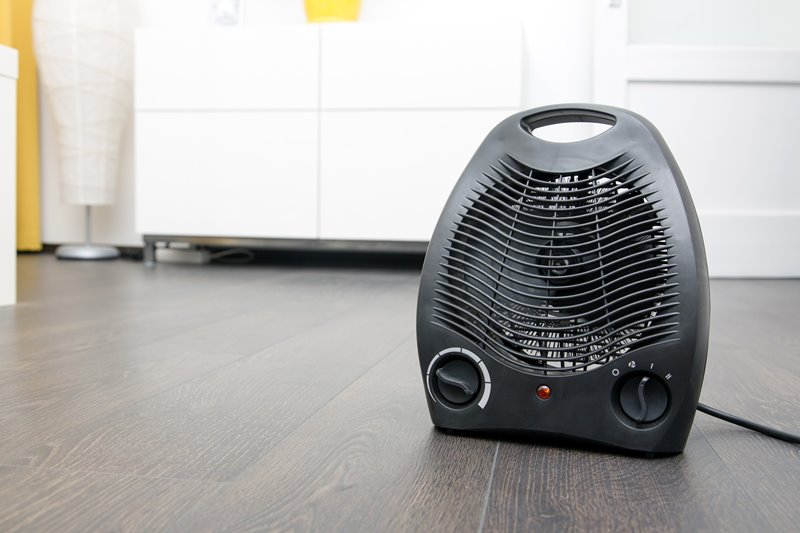
The fan heater coil heats up almost instantly. The air driven through it quickly heats up and fills the room with warmth.
It turns out that if you convert (invert) the alternating current coming from the electrical network into direct current, simultaneously changing its frequency and voltage, you can significantly increase the power of a device built on this principle. The inverter heater is equipped with a fan, but is much quieter and consumes 40% less energy than conventional units. The main advantage is that when the set temperature is reached, the most economical device continues to operate at minimum speed. This avoids high costs energy the next time you turn it on. Air conditioners, which are sometimes used to heat residential premises, are based on the same operating principle.
Infrared rays
The sun heats the earth, and it, in turn, gives off heat to the air. Due to the movement of warm air masses, the surrounding space warms up. Electrical infrared heaters operate in a similar way. They emit infrared waves, the parameters of which are comparable to the long-wave spectrum of solar radiation. Exposure to infrared waves has a beneficial effect on the human body. They deeply warm muscle tissue and improve well-being. The most efficient heater based on infrared radiation creates a comfort zone almost instantly even in a very cold room.
Depending on the size of the apartment, you can choose the most suitable model. Thus, the Camelot infrared electric heater is capable of heating an area of up to 40 m². For small rooms TermoPlaza and UFO are more suitable. All units are produced in various options- floor, wall, ceiling, portable. Installation of the devices is so simple that it can be done even without calling a specialist. There are special requirements for economical garden heaters. After all, they are installed not only indoors, but also on open verandas.
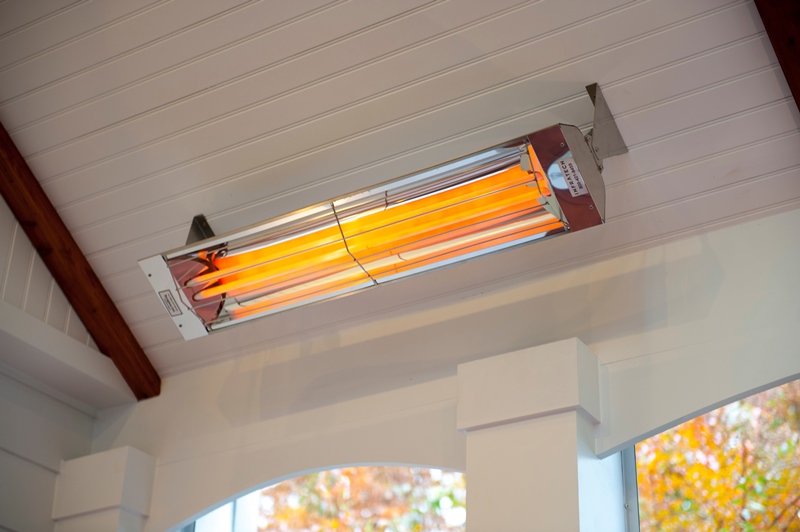
Thanks to the directed effect, heat is not dissipated, but is concentrated in the part of the space where it is needed.
The recently introduced carbon fiber units have proven themselves well. In them, IR radiation is generated not by a tungsten filament, but by a carbon (carbon) filament. The rays heat surrounding objects to a depth of 2 cm, so even after the device is turned off, heat transfer continues for a long time. To understand which heater is more economical: oil or carbon, it is enough to compare only 2 parameters. With a power consumption of 1 kW, the heating area oil device is 10 m², and the carbon unit is capable of serving an area of 30 m².
The advantage of modern infrared heaters is their local effect. They create comfortable conditions on small area without dissipating heat into an unused part of the room. However, this is also their disadvantage, since the room warms up unevenly. Another minus - high price, although devices with a carbon filament are cheaper than those with a tungsten filament.
Which heater is better (video)
Combined impact devices
A combined heating method allows you to avoid the occurrence of too cold or hot areas in the premises. In this case, infrared waves do not directly affect objects. They heat up the ceramic heating panels, which then transfer heat into the room. The combined device consists of several layers: a metal body, a heating element and a heat-resistant ceramic plate.
The temperature of the internal surface of the stove is 80-85º C, while on the outside it does not exceed 70º C. Ceramics perfectly accumulate heat and are capable of long time give it away when the device is turned off. If the home is equipped with a multi-zone electric meter, the unit timers can be set so that the infrared ceramic heaters turn on during the cheapest tariff. The panel is equipped with a programmable thermostat, which allows you to significantly save energy, and a “child lock”, thanks to which electric heating devices have become completely safe.
A similar device has a unit in which they simultaneously heat internal surfaces 2 panels at once. One of them is ceramic, the other is steel, having a special coating that can accumulate heat. This device called bio convector. Its steel component, which serves as an air intake, heats up to 90º C on the rear side, which causes active natural convection of air. A ceramic stone panel heated from the inside to 80º C becomes a source of infrared radiation.
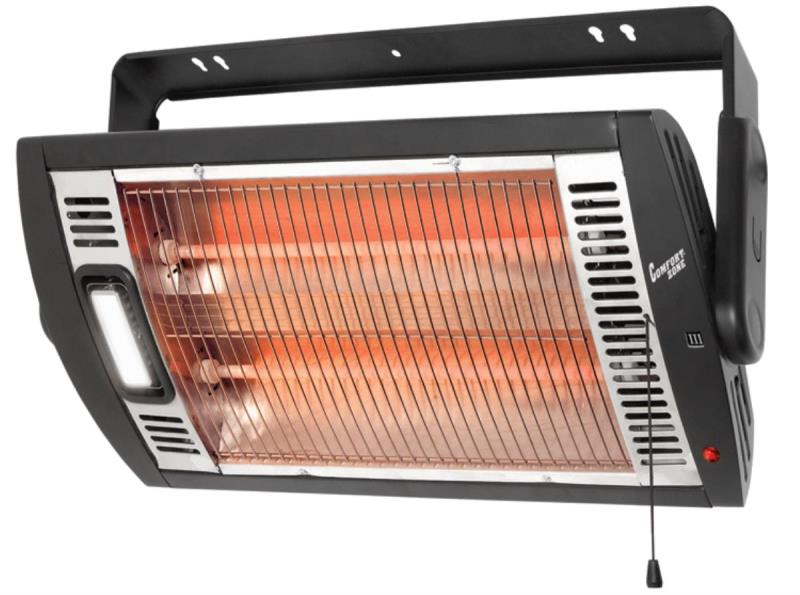
Which heaters are the most economical and efficient? Most experts prefer infrared units with a ceramic panel. They provide quick and uniform heating of the room, do not dry out the air, do not burn oxygen and do not cause the movement of dust particles. Modern devices with a high heat transfer coefficient they consume much less electricity than traditional heating devices. The thermoregulation system and timer allow you to further reduce energy costs. The cost of the unit is not very low, but it has a high level of safety and is able to operate without repair for several decades.
Latest developments
A special heat source has been developed for new generation plasma heaters. The generation of infrared rays occurs due to the resonant vibrations of silver molecules on the surface of the “glass” screen. After the glass warms up to a certain temperature, it itself begins to give off heat, and from that moment on, electricity consumption is significantly reduced. Created on the basis of applied nanotechnology, the device emits heat at an angle of 180º, which contributes to its uniform distribution.
Plasma devices do not burn oxygen or dry the air, but they help fight room dampness and fungal microorganisms. Wavelength and others physical characteristics emissions from modern heaters coincide with similar indicators sun rays, therefore the devices are absolutely safe and do not pose a fire risk. They do not interfere with sleep, as they operate silently and are not sources of visible light. When replacing traditional heating devices for “plasma” the economic effect reaches 65-70%.
The security system of the device is equipped with overheating protection and a sensor that records the integrity of the glass. It is possible to program the temperature and heating mode. Ceiling and wall heaters are easy to install since they weigh no more than 5 kg. The floor-standing version is equipped with wheels for transportation to another room, a system for changing the angle of inclination and vertical movement of the screen. Economical plasma-type electric heaters externally resemble the already familiar LCD monitor or TV. They are accompanied by an exquisite design, patterns on the glass surface, built-in FM radio and MP-3 player, giving home comfort lighting system. The only drawback of plasma units is their high price.
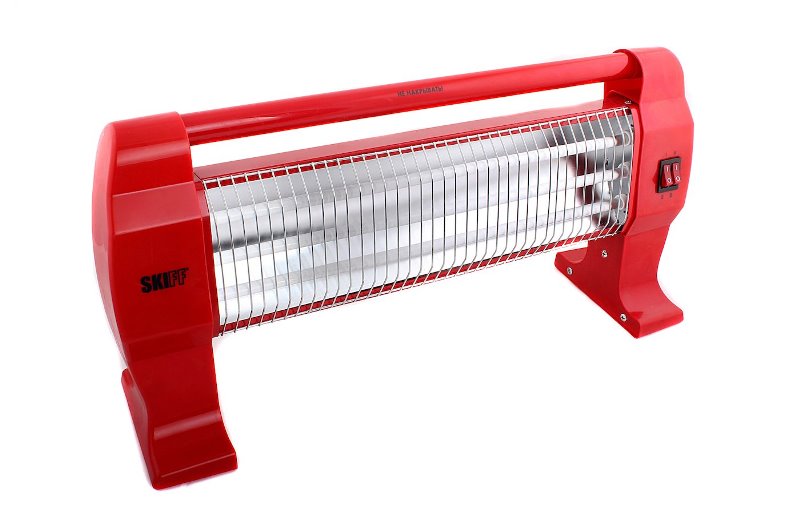
The ratio of the cost of the device and its effectiveness
If there is a need for additional heating occurs infrequently and for a short time, you can choose an inexpensive device. But for long-term operation, and especially as the main source of heat, it is still better to purchase new generation electric heaters: economical, although expensive. The high costs of equipment will soon pay off, and its reliability will allow you to avoid investing additional funds in Maintenance and repairs.
With an economical home heater, you can save 60 to 80% on energy. After all, it is not necessary to heat the entire room around the clock. During the day, a device that has warmed up overnight and is already turned off is able to maintain a comfortable temperature for a long time. Thanks to the timer, you can set it so that it turns on in the last hour before getting up or coming home from work.
As a local source of heat where family members are most often located, you can use efficient but extremely economical film-type heaters. Their weight is only 300-400 g, and power consumption is from 250 to 400 W. They hang on the wall like ordinary paintings, but thanks to infrared radiation are capable of significantly heating the area of the room in the area of their influence. If necessary, the film device can be rolled up and stored in the pantry for the summer.
Thus, best heater- This is a safe device that allows you to significantly save energy. This occurs both due to the design features of the housing and heat source, and due to the use additional functions devices. If you need to organize a system for constant and uniform heating of the entire room, it is more rational to use ceramic panels, which slowly accumulate but retain heat for a long time. To create temporary comfort zones, quickly heating devices that emit infrared waves are more suitable.
And a little about secrets...
Have you ever experienced unbearable joint pain? And you know firsthand what it is:
- inability to move easily and comfortably;
- discomfort when going up and down stairs;
- unpleasant crunching, clicking not of your own accord;
- pain during or after exercise;
- inflammation in the joints and swelling;
- causeless and sometimes unbearable aching pain in the joints...
Now answer the question: are you satisfied with this? Can such pain be tolerated? How much money have you already wasted on ineffective treatment? That's right - it's time to end this! Do you agree? That is why we decided to publish an exclusive interview with Professor Dikul, in which he revealed the secrets of getting rid of joint pain, arthritis and arthrosis.
Attention, TODAY only!
The cold season is approaching, the days are getting shorter, and the house is getting colder every day. At such times, you have to think about the need to keep warm at home or at work. One of best solutions What you can do in this situation is to use a heater, having previously decided which heater to choose for your home. Manufacturers of these household appliances They are releasing more and more new models, and choosing something specific among them is becoming more and more difficult. Below we will describe recommendations on how to choose a heater for your home.
What is a heater
The whole meaning of this device can be understood from its name. Heater - it heats, thereby performing the only function assigned to it. Electric heaters can be used in an apartment or private house, in a country house or in an office. They are quite effective and simple, and power supply devices allows them to compete on equal terms with gas heating.To distribute heat, heaters use the principles of forced or natural circulation. In addition, they can dissipate heat using combined circulation or using radiation. Later models of heaters can not only increase the room temperature, but also provide cleaning or humidification. As a rule, such a wide range of work is performed by universal heat fans that can be used to dry wet plaster, wet laundry and at the same time warm the room.
The most common misconceptions when choosing a heater
Consultants in hardware stores are required to sell as many products as possible - that's their job. It is not surprising that when working with a client, consultants use standard, most advantageous phrases, which often turn out to be nothing more than a banal invention.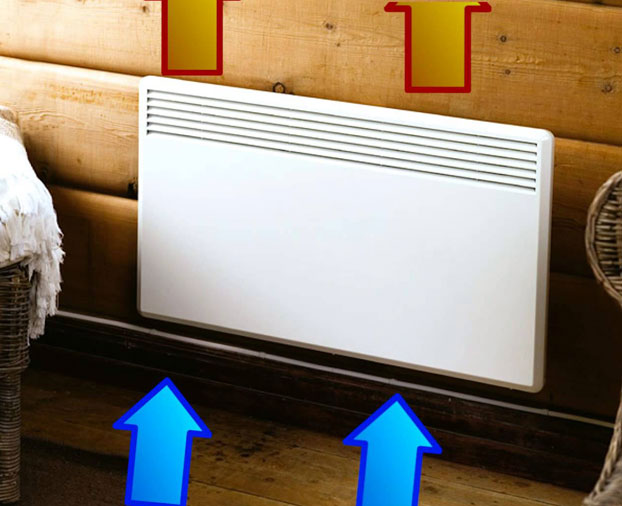
For example, " this model The heater does not dry the air." Any heater dries out the air: when the air temperature increases, the air humidity drops proportionally. The expression “this heater provides much greater efficiency” is also far from the truth - a heater of any type and brand uses the maximum of the energy received and converts all of it into heat, so it is impossible to talk about heat or energy losses. The myth about “a heater that burns oxygen” is also far-fetched, because oxygen can only be burned with an open flame, which simply does not exist when electric heaters operate.
How to install a heater
Choosing a heater that is ideal in all respects is a rather difficult task. There is such a bunch of parameters as “installation method - type of heater”. That is, when choosing a model, you should immediately think about how it will be located. For greater clarity, you can look at the photo, which shows different schemes installations.Permanently located heaters can be installed on a wall or ceiling. As a rule, such models look quite aesthetically pleasing and will not spoil the overall picture. Installing a heater on a wall usually involves creating a certain angle of inclination of the device and the presence of a small gap between the body and the wall, which will make it easier to maintain the heater in the future.
Heaters designed for horizontal or vertical installation, practically do not take up free space, since they can be installed on almost any free space. There are heaters that are designed to be installed under suspended ceilings. Floor-standing options are often equipped with wheels or legs.
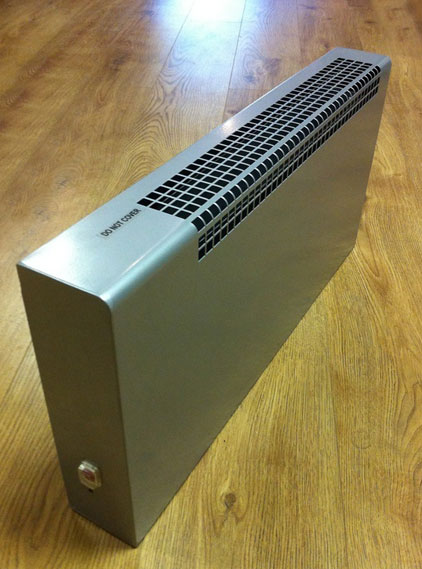
Portable heaters are great for constant travel or for use in rental housing. Such models are characterized by compact dimensions, light weight and pleasant appearance.
What does heater power affect?
Power is a fundamental parameter on which the heated area will depend. An approximate calculation shows that 1 kW of power heats about 25 m3 of space (provided there are no other types of heating and the room is well insulated). When calculating power for typical apartments, the ratio of 1 kW per 10 m3 is used with a ceiling height of about 2.5 meters.Availability central heating naturally reduces required power heater. As a rule, a power of 1-1.5 kW perfectly heats a 25-meter room. The latest models of heaters are equipped with thermostats that allow you to maintain the set temperature temperature regime. A small drawback of thermostats: the lack of a degree scale, which allows you to set the temperature based on your feelings.
Classification of heaters
As a rule, heaters are classified depending on the principle of operation and method of fastening. For selection suitable model it is necessary to take into account some parameters: how much area should be heated, how the device will fit into the interior and how long its operation is designed for. Manufacturers produce different types heaters, and only the right choice will allow you to warm the air in the room to an acceptable temperature.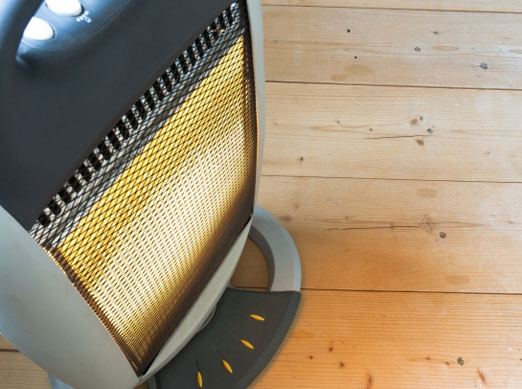
Oil radiator
Perhaps oil heaters for home can be called the most popular. Rated power varies from 1 to 2.5 kW. In a hermetically sealed housing filled with oil, there is a spiral, the heating of which leads to heat transfer to the oil. The hot oil, in turn, transfers heat to the housing, from which the heat is dissipated into the air.Oil heaters Well suited for heating apartments or cottages. When a certain air temperature is reached, the heater automatically turns off, and when it drops below a certain threshold, it starts again. The temperature of the radiator housing usually does not exceed 60 degrees Celsius. The disadvantages of such a heater: a rather large body and a long warm-up time.
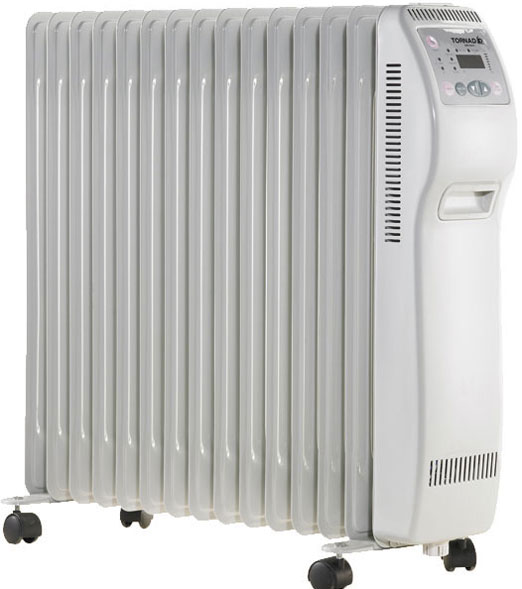
Electric convector
Visually and in terms of their performance, convectors are very similar to oil heaters, but are much better suited for installation as central heating. This type of heater can be used in any room. This device is quite unpretentious, is not afraid of moisture and works perfectly without grounding, which makes it possible to use it around the clock (read: " ").The principle of operation is based on the movement of air through a special heating element. The constant movement of air is due to the fact that cold air is always lower than warm air. From here we can deduce helpful advice: the lower the convector is installed, the higher the temperature it can provide (read also: " ").
Heat fan
This type The heater belongs to the budget category. As a rule, fan heaters are used to quickly heat air in small isolated rooms. These devices are different small in size and fit equally well on both the floor and the wall. A fan heater is the best answer to the question of how to choose a heater for a room.The air entering the fan heater is heated, receiving heat from the hot coil, after which it is distributed throughout the room under the action of the fan. For better heating, the fan can be rotated. Heat fans heat the air very quickly and distribute heat well throughout a given volume. The built-in thermostat allows the device to work automatically. Disadvantage: Quite loud noise produced when operating in fast mode.
Infrared heater
IR heaters are the most modern home heaters. It is better to use such a device as a temporary heater, despite its efficiency (read: ""). The principle of operation of this type of heater differs significantly from all previous ones: infrared devices heat not the air, but objects falling into the “affected zone”. A working IR heater is like a local sun, heating everything it reaches.This type of heater is very economical due to its versatility and does not create any emissions. environment and completely eliminates the risk of detonation natural gas, since it is not needed for operation.
Which heater to choose for your home
Choosing a heater requires attention to the following nuances:- availability is required serial number goods;
- electrical contacts must be intact and reliable - there are known cases when, due to poor contact, short circuit;
- the wiring of the device should also not raise doubts about its quality;
- it is necessary to ensure the quality and good performance of the heating element;
- The wire plug must be made of quality materials and is equipped with a grounding terminal;
- if it is impossible to check any of the previous points, then you should make sure that you have a quality certificate - in this case, the risk of purchasing a bad product is almost zero;
- The product body or packaging must be marked European quality CE, which confirms the safety of using this device.
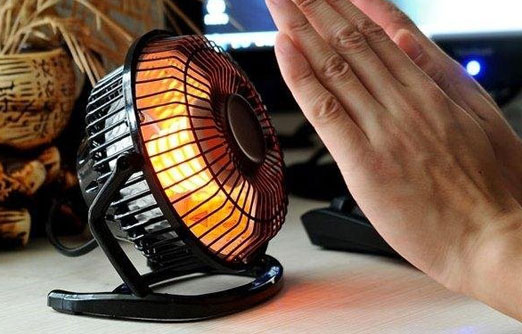
An infrared heater is well suited for rooms with a high dust content; in a children's room you can install a wall or ceiling unit, and for wet areas Only moisture-resistant models are suitable. When choosing a device, it is necessary to calculate the expected heating area so as not to purchase a more powerful heater.
When choosing between expensive and cheap devices, preference should be given to the first option: as a rule, budget models are not equipped with a thermostat or overheating sensor, and the material of such heaters is of lower quality.
How to choose a heater brand
Oil heaters are still in steady demand, despite the more than half-century history of their creation. Heat fans, on the other hand, are experiencing a decline in popularity. Besides, foreign manufacturers Our domestic colleagues are literally stepping on the heels, producing increasingly high-quality heaters that meet European standards.The Icoline company has been producing electric heaters for several years, but there is no reason to doubt the quality of the company’s products - IR heaters of this brand are excellent for year-round heating.
The Fenix company has been on the market for quite a long time, and during this time it has managed to establish itself as an excellent manufacturer of low-temperature IR heaters.
The Noirot company has taken a different route: this manufacturer produces convection heating systems, fit perfectly into almost any interior. The manufacturer Ballu specializes in producing high-quality budget models heaters. The company is pleased with the presence of a wide range of devices.
Frico is a company that produces high quality industrial and semi-industrial heaters. The most popular domestic manufacturers can be called Tropic and ELARA, which create high-quality products at fairly affordable prices.
Heater operation
For the normal and safe operation of heaters, it is enough to know and follow a few simple rules:- the heater must be connected to a working outlet, and no more than one device per outlet;
- never place any objects in front of the heater (this is especially true for window curtains, which can easily catch fire when heated for a long time;
- If there is no thermostat, you should not leave the heater overnight;
- It is strictly forbidden to place or hang foreign objects on the heater.
Now the question of which heater to choose for your home has an answer, and the phrase “I need a heater - which one should I choose?” loses its meaning. The recommendations described will help you choose the most suitable heater, and operating tips will help protect the purchased device from damage.
Video tips on which heater to choose for your home:




